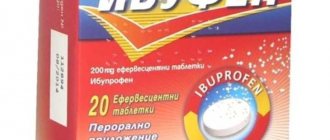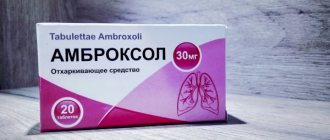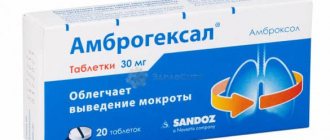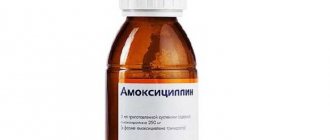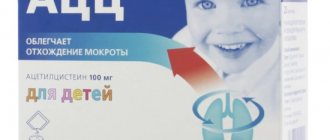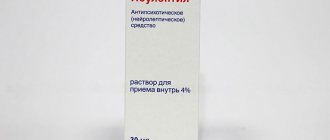Release form and composition
The drug is released in the form:
- Round white tablets containing 30 mg of ambroxol hydrochloride and excipients: lactose monohydrate, calcium hydrogen phosphate dihydrate, corn starch, sodium carboxymethyl starch, magnesium stearate, colloidal silicon dioxide. In blisters of 10 pieces;
- Long-acting hard gelatin capsules containing 75 mg of ambroxol hydrochloride and excipients: microcrystalline cellulose, eudragit RL30D and RS30D, triethyl citrate, magnesium stearate, titanium dioxide, red iron oxide dye. In blisters of 10 pieces;
- A colorless solution for inhalation and oral administration containing 1 ml (1 ml = 20 drops) 7.5 mg of ambroxol hydrochloride and excipients: methyl parahydroxybenzoate, propyl parahydroxybenzoate, sodium disulfite, citric acid, sodium hydroxide, water. In dropper bottles of 50 ml;
- Yellowish syrup containing in 1 ml 3 or 6 mg of ambroxol hydrochloride and excipients: benzoic acid, sodium disulfite, citric acid monohydrate, sodium hydroxide, povidone, sorbitol 70% solution, glycerol 85%, sodium cyclamate, raspberry flavor, purified water. In dark bottles of 100 ml with a measuring spoon.
Price (where to buy)
The cost of Ambrohexal tablets is about 84 rubles for 20 pieces.
Long-acting capsules will cost 120 rubles for 10 pieces.
A bottle of liquid for inhalation costs about 92 rubles per 50 ml.
The syrup costs approximately 103 rubles per 100 ml.
- Online pharmacies in RussiaRussia
ZdravCity
- Ambrohexal tablets 30 mg 20 pcs. Salutas Pharma GmbH
102 rub. order
Pharmacological properties
Pharmacodynamics
Ambroxol, the active component of Ambrohexal, is characterized by expectorant, secretolytic and secretomotor effects. It stimulates the work of serous cells of the glands located in the bronchial mucosa, increases the production of mucous secretion and enhances the release of surfactant in the bronchi and alveoli. Ambroxol also normalizes the disturbed balance of the mucous and serous components of sputum and reduces the viscosity of sputum by activating enzymes responsible for hydrolysis and promoting the release of lysosomes from Clara cells. This compound intensifies the motor activity of the ciliated epithelium, activates mucociliary transport and facilitates the process of removing mucus from the respiratory tract.
Typically, the therapeutic effect of ambroxol taken orally is observed after 30 minutes and lasts 6–12 hours, depending on the dose taken.
Pharmacokinetics
When taken orally, ambroxol is absorbed quickly and almost completely. The maximum concentration of the substance in this case is achieved 1–3 hours after administration.
Ambroxol is metabolized in the liver, forming metabolites excreted in the urine (glucuronides, dibromanthranilic acid). It binds to plasma proteins by approximately 85%. The half-life from blood plasma is 7–12 hours. The total half-life of ambroxol and its metabolites is approximately 22 hours. 90% of the compound is excreted through the kidneys in the form of metabolites. Less than 10% of ambroxol is excreted unchanged in the urine.
Since ambroxol binds to proteins to a significant extent and has a large volume of distribution, and is also characterized by slow re-penetration from tissues into the blood, forced diuresis or dialysis does not significantly affect its elimination. In patients with severe hepatic dysfunction, the clearance of ambroxol is reduced by 20–40%. In severe renal failure, the half-life of ambroxol metabolites increases. The substance also easily penetrates the placental barrier and into breast milk.
Indications for use
Ambrohexal is prescribed for the treatment of:
- Acute and chronic diseases of the respiratory tract, characterized by the formation of viscous secretions;
- Bronchial asthma with difficulty in sputum discharge;
- Chronic obstructive pulmonary disease;
- Pneumonia;
- Acute and chronic bronchitis;
- Bronchiectasis.
Ambrohexal syrup and solution for oral administration and inhalation is also used for the treatment and prevention of respiratory distress syndrome.
What is ambroxol hydrochloride
Ambroxol hydrochloride is a substance that directly affects the secretory function of the respiratory tract, causing the glands to work more actively, which leads to increased production of sputum. In addition, Ambroxol directly affects the motor function of the trachea and bronchi, which explains the expectorant effect. The tissues of the upper and lower respiratory tract are instantly irritated at the slightest fluctuations in the ciliated epithelium, causing a cough that easily expels liquid sputum along with the pathogen.
Contraindications
- First trimester of pregnancy;
- Hypersensitivity to the active substance (ambroxol) and auxiliary components of the drug.
According to the instructions, Ambrohexal in the form of tablets is allowed from 6 years of age, capsules - from 12 years of age.
The medication is prescribed with caution to nursing women, as well as against the background of:
- Peptic ulcer of the stomach and duodenum (due to the risk of possible exacerbation of the disease);
- Kidney and liver failure.
Analogs
Level 4 ATX code matches:
Mukolik
Abrol
Ambrosan
Bronchorus
ACC 100
ACC 200
ACC Long
ACC
Mukolwan
Lazolvan
Bromhexine 8
Bromhexine 8 Berlin-Chemie
Bromhexine
Bronchobos
Carbocisteine
Erdomed
Pulmozyme
Pectolvan C
Halixol
Ambrobene
Abrol, ambroxol, ambronorm, bronchoval, flavamed for cough, ambrosal, lasolvan, lazongin, ambrobene, ambrolitin, ambrospray, ambrochem, bronchoval, lazolex, mucosol, medox, pulmibrom, mucotablin, medovent.
Lazolvan or Ambrohexal - which is better?
Both drugs contain the same active ingredient ambroxol. The effectiveness of the impact is approximately the same. The cost of Ambrohexal is lower than that of its analog Lazolvan .
Instructions for use of Ambrohexal: method and dosage
Ambrohexal syrup is prescribed for children over 12 years of age and adults 3 times a day, 2 scoops (30 mg). Maximum – 120 mg per day. After the condition improves, it is recommended to reduce the frequency of administration to 2 times a day.
For children, syrup is used according to the following scheme:
- Children 6-12 years old – one measuring spoon 2-3 times a day;
- Children 2-5 years old – 0.5 scoops 3 times a day;
- Children under two years old – 0.5 scoops 2 times a day.
For children over 12 years of age and adults, the first few days of treatment are prescribed 1 tablet of Ambrohexal 3 times a day, after which the frequency of use must be reduced to 2 times a day. A single dosage for children 6-12 years old is 1/2 tablet.
Capsules are taken after meals in the morning or evening. The daily dosage for adults and children over 12 years of age is 1 capsule.
Solution for oral administration and inhalation Ambrohexal is usually prescribed 3 times a day, 4 ml (30 mg). After the condition improves, the frequency is reduced to 2 times a day. For children 5-12 years old, the maximum daily dose of the drug in this dosage form is 45 mg, divided into several doses, for children 2-5 years old - 15 mg. The solution is taken after meals by adding it to tea, fruit juice, milk or water.
Inhalations with Ambrohexal solution are indicated up to 2 times a day. Single dosage for all age groups – 2-3 ml.
The duration of treatment is determined by the doctor individually depending on the indications and severity of the disease. A doctor's supervision is necessary when taking the product for longer than 4-5 days.
Side effects
The drug may cause:
- Urticaria;
- Contact allergic dermatitis;
- Skin rash;
- Angioedema;
- Anaphylactic shock;
- Dry mouth;
- Diarrhea;
- Headache;
- Weakness;
- Nausea;
- Vomiting;
- Rhinorrhea;
- Constipation;
- Gastralgia.
When using ambroxol in high doses, you may also experience nausea, diarrhea, vomiting, and dyspepsia. For treatment, induce vomiting, wash the stomach, and eat fat-containing foods.
special instructions
Caution requires the use of Ambrohexal against the background of a weakened cough reflex or impaired mucociliary transport, since there is a risk of sputum accumulation.
Against the background of severe impairment of liver or kidney function, the use of lower concentrations of Ambrohexal or an increase in the interval between doses of the medication is indicated.
Use of the medicine before bedtime is not recommended.
Against the background of bronchial asthma, Ambrohexal may increase cough.
During drug therapy, breathing exercises are not recommended. In cases of severe disease, it is necessary to perform aspiration of liquefied sputum.
Impact on the ability to drive vehicles and complex mechanisms
According to the instructions, Ambrohexal does not have a negative effect on the ability to drive a car or operate highly complex mechanisms.
Use during pregnancy and lactation
Ambrohexal is prohibited for use in the first trimester of pregnancy. Its administration in the second and third trimesters is allowed if the possible benefits of treatment for the mother significantly outweigh the potential risks for the fetus.
Ambroxol easily penetrates the placental barrier. The results of animal experiments confirmed that the drug does not have a significant effect on embryofetal and postnatal development, as well as childbirth. The active component of the drug is excreted in small quantities into breast milk, so during treatment it is necessary to consider the advisability of stopping breastfeeding.
How long to take Ambroxol
If an infection occurs in the respiratory tract, the source of infection must be removed from the body as soon as possible, which is actively facilitated by Ambroxol. However, often the cause of cough is bacterial infection of the lower respiratory tract, which the body cannot always cope with on its own. Therefore, over-the-counter use of the drug is possible for no longer than 5 days. If after this period the symptoms of malaise persist, the patient must consult a doctor to prescribe antibacterial therapy.
Reviews about Ambrohexal
According to reviews, Ambrohexal in tablet form is very well tolerated and demonstrates high effectiveness in the treatment of severe dry cough. There are practically no side effects when treating with the drug. Many patients like it because of its low cost and accessibility. The syrup has the same pharmacological properties and attracts patients with a pleasant sweetish taste. Usually, within a week after the start of therapy, the cough in most patients disappears without a trace.
Inhalations with Ambrohexal solution also have positive reviews. The main advantages of the drug are the variety and convenience of release forms, acceptable treatment results and rapid recovery with its use. Parents note that inhalations with Ambrohexal and saline help to relieve children from painful coughing attacks in the shortest possible time. However, there are references to the unpleasant taste of this dosage form.
Ambroxol for children: Komarovsky
Popular pediatrician Evgeny Komarovsky reminds parents that during periods of illness it is especially important for a child to drink plenty of fluids, which will ensure natural maintenance of high-quality sputum production.
Adding Ambroxol to the inhaler requires special attention: taking it at night is strictly contraindicated. Otherwise, the child will cough all night, depriving himself and the whole family of sleep.
It is important to remember that Ambroxol is not a cough suppressant. This is a cough stimulant. In other words, taking the drug in any dosage form will lead to increased and more frequent coughing, which ensures timely removal of mucus from the lower respiratory tract.
